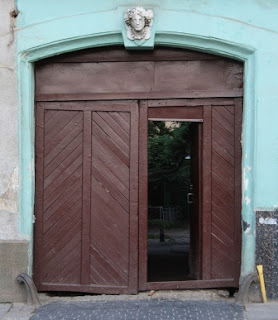Lviv's Boot Scrapers, Part II

A few more boot scrapers from Lviv and a nearby village. located inside Les Kurbas Theater, behind doors that lead to Smachna Plitka restaurant It was quite a challenge trying to snap a picture of this last one. First of all, I needed to figure out the code to the door. And second, I encountered an angry barking dog, who did not want to let me take the picture. The boot scraper is located next to a staircase behind two swing doors at the end of the main hallway, and every time I tried to open the doors and walk inside, the dog would start barking and running down the stairs toward me. (Though I must admit it was a pretty small dog - but it was still scary!) So basically I had to take the picture through the window in the door, specifically through a part were some glass was missing. This one below is located near the front of an old wooden church in Zhurivka, a village very close to Lviv. A great-grandmother of mine was born in this village, so it is quite l...



